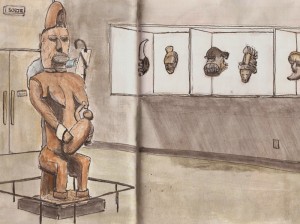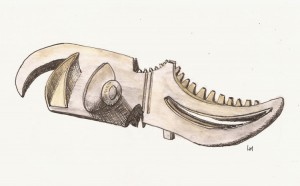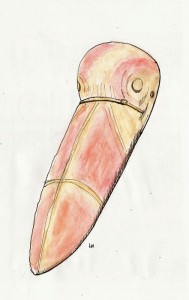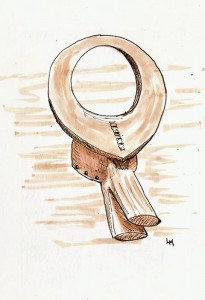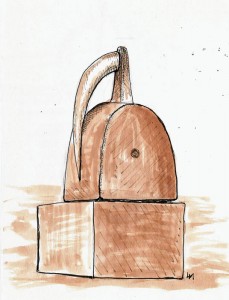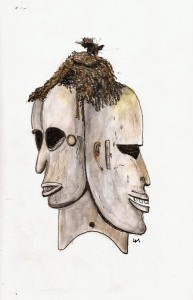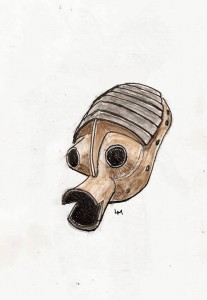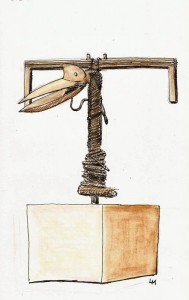I continue to use our Musee de la Civilisation as though it were closing soon. That’s not the case, thank goodness, but I need need my daily fixes of sketching, now, don’t I?
I’ve switched my attention from Nigerian masks to Nigerian statues, of which there are many in the exhibit. Before sharing them with you, however, I thought I’d talk a bit about sketching in museums.
Museum Sketching
I’m no expert about anything related to sketching but I play the role of an urban sketcher almost daily. Because it’s cold in Quebec, my urban sketching for the past few months has been in museums and here are a few things I’ve learned.
1) Know the rules
Every museum has rules and the best way to get on the good side of the administration and security is to follow them. Even inquiring about rules is seen as a good thing.
2) Talk to the people who work there
This is particularly important. Show them your sketches. Tell them how great it is that you can sketch in ‘their’ museum. Make a point of asking if your location is ok, and try to choose locations that will be out of the way of people wandering the museum. There’s no need to hide but often a bit of thought leads to a good compromise.
3) Adjust your materials to a museum milieu
My outdoor sketching kit includes watercolors, collapsible brushes and small bottles of water. My museum kit includes watercolor pencils and a waterbrush. If you use a pencil, consider switching from an eraser that drops debris all over the floor to a kneaded eraser. And keep your working footprint as small as possible. I have a tripod stool and my small art bag leans against it behind my feet while I’m sketching.
4) Buy a light
 Museums often keep light levels low in their exhibit rooms because many of the artifacts can be damaged by light. Buy a clip on light to illuminate your work. These are inexpensive – mine cost me $13.
Museums often keep light levels low in their exhibit rooms because many of the artifacts can be damaged by light. Buy a clip on light to illuminate your work. These are inexpensive – mine cost me $13.
I also carry a small piece of masonite, cut to the size of an open sketchbook. I clip the sketchbook to this, making this unit easy to hold while walking around. It serves two purposes. One is to support the sketchbook while you sketch but the other is to keep it open when you’re not as open sketchbooks stimulate more interest from museum-goers.
5) Talk to patrons
Museum goers are curious folks and they’ll be curious about your sketching. Talk to them; particularly the kids, who are often more bold than their parents. Engage them in conversations. Not only is this fun, if done regularly, the museum staff will notice and come to understand that you are an asset as well as a dumb cluck who sits in their museum day after day sketching.
About Them Nigerian Statues
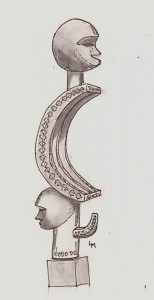 I promised some Nigerian statue sketches. Here are a few that I’ve done recently. All are done with Pilot Prera, Lex Gray ink, in a Stillman & Birn Epsilon sketchbook.
I promised some Nigerian statue sketches. Here are a few that I’ve done recently. All are done with Pilot Prera, Lex Gray ink, in a Stillman & Birn Epsilon sketchbook.
While the masks seem to be made of wood, the statues are made from a variety of materials. This one is carved from a gray rock that looks like granite. It is truly gorgeous, much more so than my sketch indicates.
 I fell in love with this bird which isn’t, strictly speaking, a statue. Rather, it’s a stopper for a large jug of some kind (thus the pointy thing at the bottom) It’s made from wood and, as tradition seem prone to dictate, covered in a very thin mud of some kind.
I fell in love with this bird which isn’t, strictly speaking, a statue. Rather, it’s a stopper for a large jug of some kind (thus the pointy thing at the bottom) It’s made from wood and, as tradition seem prone to dictate, covered in a very thin mud of some kind.
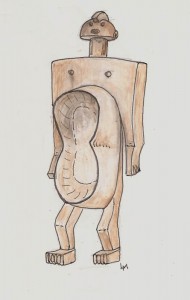 This next one isn’t a statue either. The large hollowed out area on its belly serves as a cup and, somehow, it’s used during funeral ceremonies. The sign says it allows two people to drink simultaneously. All I can say is that they’d better be very good friends.
This next one isn’t a statue either. The large hollowed out area on its belly serves as a cup and, somehow, it’s used during funeral ceremonies. The sign says it allows two people to drink simultaneously. All I can say is that they’d better be very good friends.
 This is a wonderful statue of a person carrying a child on their back. Very stylistic in its elongated proportions, I just love it. It’s made of wood with a sculpted clay covering and is more sophisticated than many of the other wood statues.
This is a wonderful statue of a person carrying a child on their back. Very stylistic in its elongated proportions, I just love it. It’s made of wood with a sculpted clay covering and is more sophisticated than many of the other wood statues.
I’m hoping spring will be sprung from its hiding place ‘real soon’ and I can get back on the street. Until that time, I’ve got lots of great statues to sketch. Hope you’ve got a museum too.
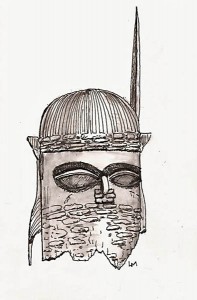 We sketched indoors and packed up around noon. I did this sketch during that session. I sort of screwed up the eyes somewhat but it was fun doing this sketch anyway. With a rock wall for a beard and hat, what’s not to like? It was done in an S&B Epsilon (5.5×8.5), with a Pilot Prera and Lexington Gray ink.
We sketched indoors and packed up around noon. I did this sketch during that session. I sort of screwed up the eyes somewhat but it was fun doing this sketch anyway. With a rock wall for a beard and hat, what’s not to like? It was done in an S&B Epsilon (5.5×8.5), with a Pilot Prera and Lexington Gray ink.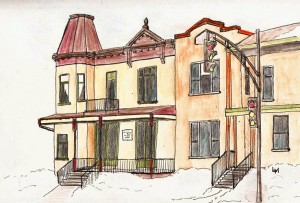 I’ve walked by this building many times and have said “I’ve got to sketch that” an equal number of times. It was built in 1927 but today was the day it was going to be sketched. Besides, I wanted to try out my new Stillman & Birn Zeta sketchbook. I used my Pilot Prera/Lex Gray combo and, because I had my museum stuff with me, I used watercolor pencils to do the color. I was uncomfortably cold towards the end but clearly spring sketching is about to begin and I’m getting excited. Sorry that much of the light blue in the sky and in the snow got lost in the scanning process.
I’ve walked by this building many times and have said “I’ve got to sketch that” an equal number of times. It was built in 1927 but today was the day it was going to be sketched. Besides, I wanted to try out my new Stillman & Birn Zeta sketchbook. I used my Pilot Prera/Lex Gray combo and, because I had my museum stuff with me, I used watercolor pencils to do the color. I was uncomfortably cold towards the end but clearly spring sketching is about to begin and I’m getting excited. Sorry that much of the light blue in the sky and in the snow got lost in the scanning process.
